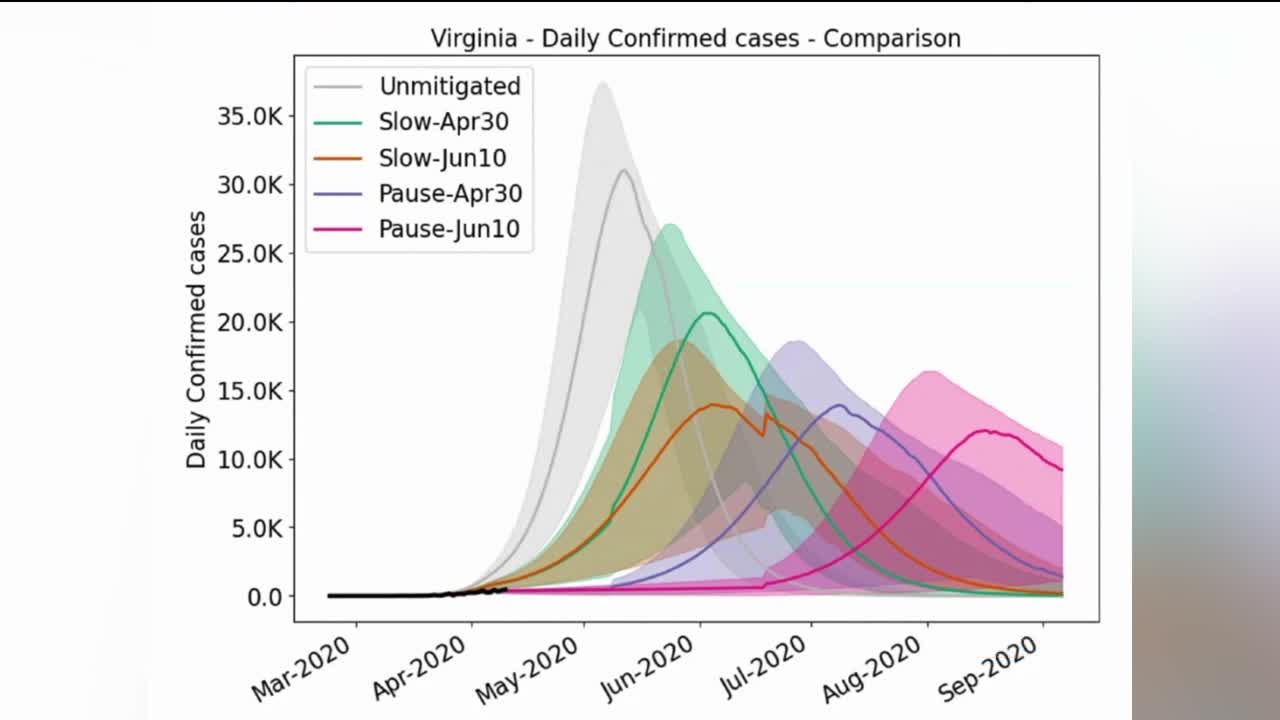CHARLOTTESVILLE, Va. -- Newly released results from a coronavirus infection rate model, designed specifically for case data in Virginia, shows social distancing efforts are making an impact and could help flatten the curve of infection in the Commonwealth.
Researchers with the University of Virginia Biocomplexity Institute released their initial findings after developing a type of “systems dynamics model,” tracking county and city specific case data provided by the Virginia Department of Health.
The model analyzes how social distancing and other policies influence the intensity of the infection rate here, the researchers said.
“Projecting future cases precisely is impossible, and probably not fully necessary,” said Brian Lewis, one of the researchers on the project. “The key part here is that we had to get to a point in the epidemic where we could observe what the effects of these social distancing measures were.”
Lewis presented data that showed on March 15, when social distancing guidelines had been in place for a few days in Virginia, the weekly mean of new cases dipped and has decreased each week since.
The model predicts the growth in new cases over the course of the next few months in several “what if” scenarios, according to the researchers. The projections are based off mitigations efforts they categorized as “slowing” the growth rate of new cases verses “pausing” them. A control element of no mitigation efforts was also run.
Each scenario was tested against dates at the end of the April and June 10, the date in which Governor Northam’s stay at home order remains in effect.
Researchers said the data shows Virginia is tracking toward the “paused” level of case intensity because of social distancing guidelines. If that scenario were to develop, Virginia would see a much lower peak in the number of new daily cases and the curve would be more flattened that other scenarios.
Officials warned multiple times that the situation is changing daily and that modeling is not precise.
“It’s important to remember this is not a crystal ball,” said Dan Carey, Secretary of Health and Human Resources. “Social distancing is important, and it’s working in Virginia. Our actions right now and going forward will affect our outcomes.”
The concern for both officials and researchers is that lifting or easing restrictions too soon could either cause a secondary peak or a flood of new cases that hospitals and healthcare centers are not equipped to handle.
Carey said he had three big takeaways from the new modeling: social distancing efforts are working, the state is optimistic about their current hospital capacity, and the state needs to be responsible in returning to the status quo in order to prevent a secondary wave of infection.
“We definitely need to develop a different tool kit besides opening everything up or opening it halfway,” Cary said. “This is not one and done, one phase. We’re going to have to work together through this as we try to get back to our normal lives.”
That “tool kit” moving forward may include measures like complex testing, such as taking worker's temperatures before entering their workplace, and advanced contracting tracing of positive cases, according to Carey.
The UVA model is one of three the state is using to trace the rate of infection and spread of COVID-19 cases. Officials are reviewing widely used University of Washington IHME model and the CHIME model published Penn medicine.
Every model or forecasting method presents its own challenges making accurate projections, so officials said they will continue to review data from various models to make decisions.
COVID-19 Precautions
Most patients with COVID-19 have mild to moderate symptoms. However, in a small proportion of patients, COVID-19 can lead to more severe illness, including death, particularly among those who are older or those who have chronic medical conditions.
COVID-19 spreads primarily through respiratory droplets produced when an infected person coughs or sneezes.
Symptoms include fever, cough, and difficulty breathing. Symptoms appear within 14 days of being exposed to an infectious person.
Virginia health officials urged the following precautions:
- Wash your hands often with soap and water for at least 20 seconds.
- Use an alcohol-based hand sanitizer only if soap and water are not available.
- Avoid touching your eyes, nose, and mouth.Cover your mouth and nose with a tissue or your sleeve (not your hands) when coughing or sneezing.
- Clean and disinfect frequently touched objects and surfaces.Stay home when you are sick.
- Avoid contact with sick people.Avoid non-essential travel.



